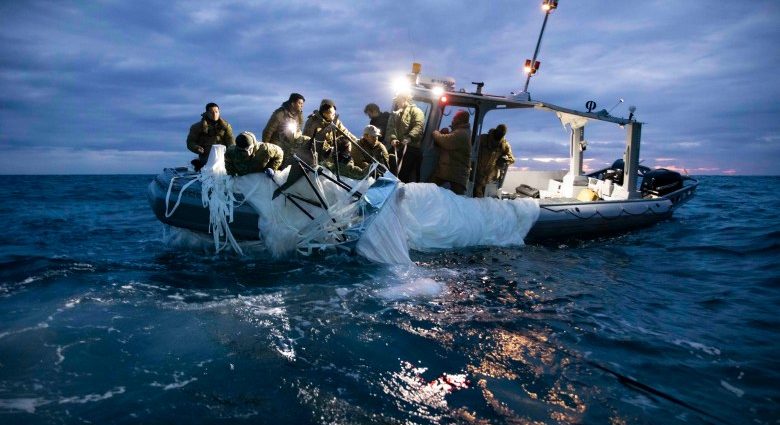Over the past week, the US has realized and revealed that an active fleet of Chinese spy balloons has been operating across the northern hemisphere for several years.
This all started to become apparent when a Chinese balloon, some 60 meters high and carrying a sensor payload of more than a tonne, was sighted by people in offices and homes in Billings, Montana. The white balloon, highlighted against a bright blue sky, was described as like a second moon.
The saga continues to evolve. After the balloon was shot down off the South Carolina coast, three more objects were similarly engaged in northern Alaska, Canada’s Yukon Territory and over one of the Great Lakes. All three were flying inside territorial airspace.
The nature and origin of these objects are still unclear. US officials say the objects were not maneuvering or communicating, helpfully noting “there is no indication of aliens or extraterrestrial activity.”
These four shoot-downs are the first in the history of the US-Canadian North American Aerospace Defense Command, originally set up during the early Cold War. In the background, another large Chinese spy balloon was understood to be overflying Costa Rica, Colombia and Venezuela.
A purposeful, ongoing program
The first balloon has already had several impacts. It quickly led to the cancellation of US Secretary of State Antony Blinken’s planned visit to Beijing of which much was hoped.
A minor domestic ruckus erupted as Republicans accused the Biden administration of being soft on China by not shooting the balloon down as early as possible. Congress voted 419-0 to condemn “the Chinese Communist Party’s use of a high-altitude surveillance balloon over United States territory as a brazen violation of United States sovereignty.”
Lastly, the US blacklisted a Chinese research institute and five aviation and defense companies, cutting them off from accessing American technology.
The implication is the equipment recovered from the first balloon’s wreckage has revealed the blacklisted organizations were involved in building it.

As more comes to light each day, China’s spy balloon program appears purposeful, well-planned, well-funded and ongoing. This was not a slapdash activity by some freelancing Chinese group but a highly organized military activity, at least partly conducted from Hainan Island on the edge of the South China Sea.
The program is likely to continue with its main focus being electronic surveillance, in particular, mapping the civil and military communication networks of other countries, presumably to aid monitoring and possible later intrusions. The Pentagon noted that over the past several years Chinese balloons have been spotted operating over Latin America, South America, South-East Asia, East Asia and Europe.
Global wind patterns mean these operations are likely to be restricted to the northern hemisphere unless the balloons are launched off Chinese naval ships.
Detecting and shooting down such balloons requires a well-organized national air defense system that most countries do not have. Nevertheless, the sudden shooting down of three more objects immediately after the first suggests the US may have gleaned critical intelligence as it tracked the first balloon while it flew across America.
The first balloon was sending data via a wireless link back to China. This link may be commonly used across the program. Knowledge of the technical characteristics of this link may have allowed the US to locate and track other balloons.
The US is sharing its newly acquired intelligence about the balloons with its allies, partners and friends. This will help others counter Chinese spy balloons over their countries.
An escalating trend
There are some implications for international relations.
First, the Chinese Communist Party doesn’t appear to mind irritating other countries. Much of what the spy balloons are doing can just as easily be done by surveillance satellites, of which China has some 260 in orbit.
In contrast, the balloons are inherently provocative. The response from the Chinese Foreign Ministry and the party’s mouthpiece the Global Times has been to deny, obfuscate and confuse, complain about the US for shooting down the first balloon, and claim the US has sent many similar balloons into Chinese airspace.

Second, the great hopes that post-Covid China would shift from the wolf-warrior diplomacy of the past several years to become a more responsible member of the international community seem dashed.
Instead, an escalating trend seems apparent, when considering other recent Chinese “gray zone” incidents. Looking forward, China seems set on “pushing the envelope” in a future where it is increasingly bellicose.
Bad signs for future crises
The balloon saga has also revealed that, in a crisis, China may be unable to adequately manage a fast-developing situation. The party apparatus may be good at implementing detailed long-range plans, but less adept at managing problems that arise quickly.
In this crisis, only the Americans seem actively involved; the statements from Beijing are at best pro forma, and certainly not meaningful interaction.
US Defense Secretary Lloyd Austin reportedly called China on a dedicated, mutually agreed crisis line, but Chinese Defence Minister Wei Fenghe declined to speak to him. This is a bad omen.
In a future US-China crisis only one side might be trying to manage the situation. The Chinese side might again freeze, with senior leaders playing the silent, nobody-home card.
The balloon saga continues to drive US-China relations downward. China’s top leaders appear apathetic, while America’s hawks seem vindicated. It’s a win-win, as Xi Jinping always talks about, but not for the wider world.
Peter Layton is Visiting Fellow, Griffith Asia Institute, Griffith University
This article is republished from The Conversation under a Creative Commons license. Read the original article.

